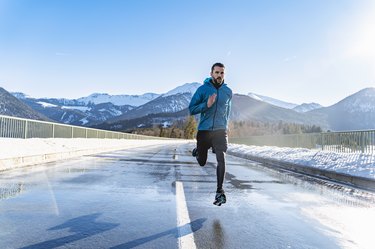
Cold weather doesn't mean you're doomed to exercise indoors until spring. Whether you run, cycle or hike, there are plenty of ways to get active in the great outdoors in chillier months — though they can take a toll on your skin.
"Winter weather is cold and dry," Joshua Zeichner, MD, director of cosmetic and clinical research in dermatology at Mount Sinai Hospital in New York City, tells LIVESTRONG.com. "If you are exercising outside, cold temperatures — especially when combined with wind — can strip the skin of essential oils, leading to dryness, irritation and impairment of the skin barrier."
Video of the Day
Video of the Day
If you plan on breaking a sweat outside this time of year, and especially if you have a skin condition like psoriasis, keep the following expert-backed tips in mind to save your skin from the harsher elements.
1. Wear Sunscreen
Sunscreen is still a must-have for outdoor workouts, even under dreary winter skies.
"Many people think sunburn isn't an issue during the winter months," says Laura Ryan, RD, certified run coach and regional endurance training coordinator for Life Time Athletic. "However, it is very important to use SPF 15 or higher on all exposed skin any time you run or exercise outside."
"Even on cloudy or cold days, the skin is still at risk for UV light damage," Dr. Zeichner adds. At the very least, apply sunscreen to your face about 30 minutes before heading out.
Related Reading
2. Protect All Exposed Skin
After applying a base layer of sunscreen, add a layer of moisturizer to help shield your skin from cold, windy weather, which can cause windburn and dry out your skin.
"Think of moisturizer like a glove for your skin, providing a protective seal over it and protecting it from the environment," says Dr. Zeichner, who recommends moisturizers containing petrolatum, an oily ingredient known as an occlusive because of the way it prevents water from evaporating from your skin, according to Harvard Health Publishing.
His top pick? Vaseline Intensive Care Advanced Repair Lotion, "an easy-to-spread lotion that does not leave the skin feeling greasy or heavy," he says. Apply it all over right before you suit up and head outside.
Because your lips can be particularly susceptible to the irritating effects of cold weather, make sure to apply lip balm, as well — and tuck a tube in a pocket for the road, Ryan adds.
3. Wear Windproof, Moisture-Wicking Workout Clothes
If you're going to be sweating in particularly cold or windy weather, make sure your outermost layer of gear — especially your gloves or mittens — is windproof, Ryan says. "I get dry hands in the colder months, so I always try to keep my hands, especially, covered."
Plus, since you do still sweat when you exercise in the cold (you just might not notice it as much as you do in the middle of the summer), opt for inner layers made with moisture-wicking fabrics, Dr. Zeichner says. "Sweat accumulating on the skin can ultimately lead to irritation or even acne breakouts," he explains.
Related Reading
4. Cleanse Quickly
The thought of stripping down immediately after a chilly workout probably doesn't appeal much, especially when you'd rather just bask in the warmth of being back inside. But it's a smart move.
"Make sure to remove any sweaty or wet clothing and shower as soon as possible to remove sweat, dirt and oil from the skin," Dr. Zeichner says.
Otherwise, you just increase the likelihood of irritation (and delay the opportunity to moisturize, but more on that later).
5. Keep Your Shower Cool
Another oh-so-real temptation you'll want to avoid after exercising in the cold: a long, hot shower. Heavenly as the hot steam might feel in the short term, it ultimately backfires on already-stressed skin.
"The water temperature should be around what you would imagine a heated pool to be during the summer, which is usually around 86 degrees," Dr. Zeichner says.
Yes, that temperature will feel unsatisfyingly cool, but it's for the best: The hotter the water, the more it strips moisture from your skin.
At that temp, you're also less likely to linger too long. Short-and-sweet rinses help you avoid stripping too much moisture from your skin, so stick to around 10 minutes max, Dr. Zeichner says.
6. Skip the Exfoliation
"If your skin is dry or visibly flaky, what it really needs is hydration," Dr. Zeichner says.
Using exfoliating brushes or body scrubs in a post-cold-weather-workout shower can irritate already sensitive skin, according to the American Academy of Dermatology.
If you still notice flakes later on or the next day, then you can get scrubbing. Immediately after, though, resist.
7. Moisturize, Moisturize, Moisturize
To replace the hydration your skin lost during your workout or in the shower — and reestablish a solid base of moisture — Dr. Zeichner recommends applying moisturizer all over within five minutes of hopping out of the shower.
If, like Ryan, your hands also get exceptionally dry in the colder months, take extra care to revive them. She swears by petroleum jelly, which she lathers on her hands before bed. "It works wonders," she says.
8. Get Plenty of Water
Dehydration affects your entire body — including your skin, Dr. Zeichner says. The issue is, you may not realize how much you sweat during outdoor winter workouts or feel as thirsty as you do during the hot summer months, leading you to accidentally under-hydrate.
Make sure you're drinking enough water by monitoring the color of your urine. How will you know you're hydrated? Look for a pale yellow color, according to UC San Diego Health.